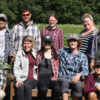If you were to travel north or south along highway 131, you would transect a patchwork of farm fields and a series of small towns that dot southwest Michigan, and one particular whistle-stop by the name of Three Rivers. As I hail from the city of Pittsburgh, whose claim to fame is the presence of three relatively large rivers, I was delighted to move to the quaint town nestled around the St. Joseph, Rocky, and Portage riverlets. Reorienting myself around the presence of water feels rather familiar.
As a recent arrival to the Rectory, the *cino intern house (still in need of a more charming title), I find that I’m settling agreeably into what has already been comfortably inhabited for most of the summer. Yet the local foot-traffic of Main street still peers curiously at our twentysomething gaggle as we eat curries and project strange sounds from the front porch, and the question, “So what exactly are you doing here again?” seems to arise daily. Yes, our presence here as “interns” or “the people who work at Huss school” is rather ambiguous, but we are noticing a growing conversation percolate as the events of the past month unveil an active and imaginative vision.
Daily life in the rectory oscillates between peaceful mornings reading poetry and haphazard and chaotic cooking explosions lasting well on into the evening. An unpredictable rhythm indeed, as our living dynamic shifts slightly with the ebb and flow of interns, visitors, and dinner guests. The stereo seems to be the central locus of the abode, where eclectic and familiar sounds accompany dinner preparation, work at the dining-room table, and most any moment where someone occupies the first floor. We’ve stocked our cupboards with bulk flours, oats, and grains from Miller’s Discount Store, locally referred to as the “Amish Shop,” and have found time to knead yeasty loaves of bread, frost vegan cupcakes, and enjoy fresh-pressed peanut butter. Tomatoes are reddening on the window sill and a great bounty of vegetables fill various nooks and crannies, giving way to collaboratively crafted summer soups, pesto’s and salads–enough for 5, 11, or 14 gathered ’round. Yet there always seems to be time for sprawled-out crafting and letter writing. Needless to say, my transition here has been pleasant, accompanied by a conscious desire for simpler, more holistic, and communal ways of living.
Why not start with homemade granola?
I have begun the quest to bake a crunchier chunkier and delectable tasting granola. Thanks to Kirstin’s suggestion, we look no further than the Mennonite (Central Committee) cookbook, Simply in Season:
Chunky Crunchy Granola
3 c. rolled oats
1 c. whole wheat flour
1/4 c. brown sugar
1 ½ t. ground cinnamon
1/2 t. salt
1/2t. ground ginger
1/4 c. oil
1/4 c. honey
1/4 c. milk
½ c. raisins, other dried fruit or nuts (pecans are good)
1. Mix together dry ingredients together in a large bowl. Make a well in the center.
2. Pour oil, honey, milk, etc. into the well. Mix thoroughly , making sure all loose flour has been incorporated.
3. Spread in 9 x 13″ pan and bake at 300°, stirring every 10 minutes, until light brown, 50-60 minutes.
After many critiques and grumbles from past attempts, the drowsy breakfast eaters now declare, “Yes! We’ve found it! So chunky! A perfect combination of salty and sweet!”
Through the small tasks including washing clothes by hand, baking daily bread, and making delightful meals from the bounty of Michigan produce, the pace of the day has elongated into calm productivity with the occasional disruption of swooping bats or spontaneous dance parties.
So what does this all have to do with the title, “Making Boo Radley Come Out,” anyway?
Maycomb was an old town, but it was a tired old town when I first knew it. In rainy weather the streets turned to red slop . . . somehow it was hotter then . . . bony mules hitched to Hoover carts flicked flies in the sweltering shade of the live oaks on the square. Men’s stiff collars wilted by nine in the morning. Ladies bathed before noon, after their three-o’clock naps, and by nightfall were like soft teacakes with frostings of sweat and sweet talcum. . . . There was no hurry, for there was nowhere to go, nothing to buy and no money to buy it with, nothing to see outside the boundaries of Maycomb County. But it was a time of vague optimism for some of the people: Maycomb County had recently been told that it had nothing to fear but fear itself.
This excerpt is from the first chapter of the southern gothic novel, To Kill a Mockingbird, written by Harper Lee. The interns have decided to revive this classic story while reading aloud after our evening meals, and though the historical setting of the novel contains many contrasts to today, the themes of this story seem to take on a new meaning for those of us dwelling in Three Rivers. The sleepy town of Maycomb, Alabama is set in the thick of the Great Depression and the early outcries of the Civil Rights movement with Harper Lee addressing issues of racism, class, inequality, economic hardship, and gender roles in the American south. While I hesitate to draw broad generalizations from this novel, this short time in small-town Michigan has reminded me that many of these issues (economic recession, racism, classism, etc.) are more than present today.
In addition to learning to live simply and imaginatively in this new home, we spend much time at Huss School–a building rich in memory and history. Afternoons at Huss usually include visits from neighborhood kids, some of whom are rather mischievous and rambunctious boys eager to wrestle and skate and bombard each of us with curious questions. These boys, who seem to teach us about both lived experience and local myth and lore of the neighborhood, remind me of the characters of Lee’s novel; children who believe that Huss School is haunted and who have rather precocious perspectives into the lives of their neighbors. Yet these kids have a fascination with the *cino project and changes happening at Huss, and, as though out of a novel, jump and cheer and chase our bicycles as we ride down their streets. These children certainly experience the inequalities ever-present in our communities, and their stories often reflect this. Yet they are eager to be involved–to help and explore and imagine this renewed space.
So while our familiarity with Three Rivers continues to grow, I am challenged by these connections, reminding me of subtle and blatant examples of injustice and social and economic hardship, but also of the hope, joy, and creativity occurring here. Through reading the story of the sleepy and tired Maycomb and the characters who seek peace and justice, there is certainly and undercurrent of optimism also found in the narrative of Three Rivers.



